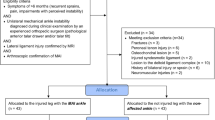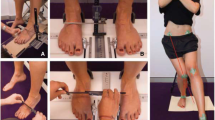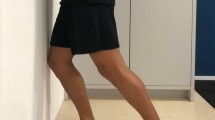Abstract
Purpose
To investigate the clinical measures of foot posture and morphology, multisegmented joint motion and play, strength, and dynamic balance in recreationally active young adults with and without a history of a lateral ankle sprain (LAS), copers, and chronic ankle instability (CAI).
Methods
Eighty recreationally active individuals (healthy: n = 22, coper: n = 21, LAS: n = 17, CAI: n = 20) were included. Foot posture index (FPI), morphologic measures, joint motion (weight-bearing dorsiflexion (WBDF), rearfoot dorsiflexion, plantar flexion, inversion, eversion; forefoot inversion, eversion; hallux flexion, extension), joint play (proximal and distal tibiofibular; talocrural and subtalar, forefoot; 1st tarsometatarsal and metatarsophalangeal), strength (dorsiflexion, plantar flexion, inversion, eversion, hallux flexion, lesser toe flexion), and Star Excursion Balance Test (SEBT) (anterior, posteromedial, posterolateral) were assessed.
Results
There were no group differences in FPI or morphological measures. LAS and CAI groups had decreased ankle dorsiflexion (p = 0.001) and greater frontal plane motion (p < 0.001), first MT plantar flexion, and sagittal excursion (p < 0.001); increased talocrural glide (p = 0.02) and internal rotation (p < 0.001) and decreased forefoot inversion joint play (p < 0.001); and decreased strength in all measures (p < 0.001) except dorsiflexion compared to healthy controls. The LAS group also demonstrated decreased distal tibiofibular (p = 0.04) and forefoot general laxity (p = 0.05) and SEBT performance (anterior: p = 0.02; posteromedial: p < 0.001; posterolateral: p < 0.001).
Conclusion
Individuals with LAS or CAI have increased pain, impaired physiologic and accessory joint motion, ligamentous tenderness, and strength in the foot and ankle. Clinicians should assess the multiple segments of the ankle–foot complex when caring for individuals with an LAS or CAI.
Level of evidence
II.






Similar content being viewed by others
References
Agnholt J, Nielsen S, Christensen H (1988) Lesion of the ligamentum bifurcatum in ankle sprain. Arch Orthop Trauma Surg 107:326–328
Bennell K, Talbot R, Wajswelner H, Techovanich W, Kelly D, Hall A (1998) Intra-rater and inter-rater reliability of a weight-bearing lunge measure of ankle dorsiflexion. Aust J Physiother 44:175–180
Beynnon BD, Murphy DF, Alosa DM (2002) Predictive factors for lateral ankle sprains: a literature review. J Athl Train 37:376–380
Colville MR, Marder RA, Boyle JJ, Zarins B (1990) Strain measurement in lateral ankle ligaments. Am J Sports Med 18:196–200
Cote KP, Brunet ME, Gansneder BM, Shultz SJ (2005) Effects of pronated and supinated foot postures on static and dynamic postural stability. J Athl Train 40:41–46
Delahunt E, Coughlan GF, Caulfield B, Nightingale EJ, Lin C-WC, Hiller CE (2010) Inclusion criteria when investigating insufficiencies in chronic ankle instability. Med Sci Sports Exerc 42:2106–2121
Doherty C, Bleakley C, Hertel J, Caulfield B, Ryan J, Delahunt E (2016) Recovery from a first-time lateral ankle sprain and the predictors of chronic ankle instability: a prospective cohort analysis. Am J Sports Med 44:995–1003
Doherty C, Bleakley CM, Hertel J, Caulfield B, Ryan J, Delahunt E (2015) Laboratory measures of postural control during the star excursion balance test after acute first-time lateral ankle sprain. J Athl Train 50:651–664
Donahue M, Simon J, Docherty CL (2013) Reliability and validity of a new questionnaire created to establish the presence of functional ankle instability: the IdFAI. Athl Train Sports Health Care 5:38–43
Durall CJ (2011) Examination and treatment of cuboid syndrome: a literature review. Sports Health Multidiscip Approach 3:514–519
Facchini SJ, Hoch MC, Smith DH, Hoch JM (2015) Intrarater and interrater agreement of the intrinsic foot muscle test. Int J Athl Ther Train 20:53–57
Feger MA, Snell S, Handsfield GG, Blemker SS, Wombacher E, Fry R, Hart JM, Saliba SA, Park JS, Hertel J (2016) Diminished foot and ankle muscle volumes in young adults with chronic ankle instability. Orthop J Sports Med 4:232596711665371
Fraser JJ, Feger MA, Hertel J (2016) Clinical commentary on midfoot and forefoot involvement in lateral ankle sprains and chronic ankle instability. part 2: clinical considerations. Int J Sports Phys Ther 11:1191–1203
Fraser JJ, Koldenhoven RM, Saliba SA, Hertel J (2017) Reliability of ankle-foot morphology, mobility, strength, and motor performance measures. Int J Sports Phys Ther 12:1134–1149
Godin G, Shephard RJ (1997) Godin leisure-time exercise questionnaire. Med Sci Sports Exerc 29:36–38
Golanó P, Vega J, Leeuw PAJ de, Malagelada F, Manzanares MC, Götzens V, Dijk CN van (2016) Anatomy of the ankle ligaments: a pictorial essay. Knee Surg Sports Traumatol Arthrosc 24:944–956
Gonnella C, Paris SV, Kutner M (1982) Reliability in evaluating passive intervertebral motion. Phys Ther 62:436–444
Greisberg J, Prince D, Sperber L (2010) First ray mobility increase in patients with metatarsalgia. Foot Ankle Int 31:954–958
Gribble PA, Hertel J (2003) Considerations for normalizing measures of the star excursion balance test. Meas Phys Educ Exerc Sci 7:89–100
Hashimoto T, Sakuraba K (2014) Assessment of effective ankle joint positioning in strength training for intrinsic foot flexor muscles: a comparison of intrinsic foot flexor muscle activity in a position intermediate to plantar and dorsiflexion with that in maximum plantar flexion using needle electromyography. J Phys Ther Sci 26:451–454
Hays RD, Bjorner JB, Revicki DA, Spritzer KL, Cella D (2009) Development of physical and mental health summary scores from the patient-reported outcomes measurement information system (PROMIS) global items. Qual Life Res 18:873–880
Hertel J (2008) Sensorimotor deficits with ankle sprains and chronic ankle instability. Clin Sports Med 27:353–370
Hintermann B (1999) Biomechanics of the unstable ankle joint and clinical implications. Med Sci Sports Exerc 31
Hoch MC, Gaven SL, Weinhandl JT (2016) Kinematic predictors of star excursion balance test performance in individuals with chronic ankle instability. Clin Biomech 35:37–41
Hubbard TJ, Hertel J (2006) Mechanical contributions to chronic lateral ankle instability. Sports Med 36:263–277
Hubbard TJ, Hertel J (2008) Anterior positional fault of the fibula after sub-acute lateral ankle sprains. Man Ther 13:63–67
Jam B (2006) Evaluation and retraining of the intrinsic foot muscles for pain syndromes related to abnormal control of pronation. Adv Phys Ther Educ Inst. https://bit.ly/2tNrmyk. Accessed 13 Mar 2015
Jazayeri Shooshtari SM, Didehdar D, Moghtaderi Esfahani AR (2007) Tibial and peroneal nerve conduction studies in ankle sprain. Electromyogr Clin Neurophysiol 47:301–304
Kim K-M, Ingersoll CD, Hertel J (2012) Altered postural modulation of Hoffmann reflex in the soleus and fibularis longus associated with chronic ankle instability. J Electromyogr Kinesiol 22:997–1002
Kosik KB, Terada M, Drinkard CP, Mccann RS, Gribble PA (2017) Potential corticomotor plasticity in those with and without chronic ankle instability. Med Sci Sports Exerc 49:141–149
Kristianslund E, Bahr R, Krosshaug T (2011) Kinematics and kinetics of an accidental lateral ankle sprain. J Biomech 44:2576–2578
Labovitz JM, Schweitzer ME (1998) Occult osseous injuries after ankle sprains: incidence, location, pattern, and age. Foot Ankle Int 19:661–667
Manske R, Wilk KE, Davies G, Ellenbecker T, Reinold M (2013) Glenohumeral motion deficits: friend or foe? Int J Sports Phys Ther 8:537–553
Martin RL, Irrgang JJ, Burdett RG, Conti SF, Van Swearingen JM (2005) Evidence of validity for the foot and ankle ability measure (FAAM). Foot Ankle Int 26:968–983
McPoil TG, Vicenzino B, Cornwall MW, Collins N, Warren M (2009) Reliability and normative values for the foot mobility magnitude: a composite measure of vertical and medial-lateral mobility of the midfoot. J Foot Ankle Res 2:6
Morrison KE, Kaminski TW (2007) Foot characteristics in association with inversion ankle injury. J Athl Train 42:135–142
Murphy DF, Connolly DAJ, Beynnon BD (2003) Risk factors for lower extremity injury: a review of the literature. Br J Sports Med 37:13–29
Nitz AJ, Dobner JJ, Kersey D (1985) Nerve injury and grades II and III ankle sprains. Am J Sports Med 13:177–182
Nyska M, Mann G (2002) Midfoot sprain. In: The unstable ankle. Human Kinetics, pp 162–166
Plante JE, Wikstrom EA (2013) Differences in clinician-oriented outcomes among controls, copers, and chronic ankle instability groups. Phys Ther Sport 14:221–226
Redmond AC, Crosbie J, Ouvrier RA (2006) Development and validation of a novel rating system for scoring standing foot posture: the foot posture index. Clin Biomech 21:89–98
Revicki DA, Kawata AK, Harnam N, Chen W-H, Hays RD, Cella D (2009) Predicting EuroQol (EQ-5D) scores from the patient-reported outcomes measurement information system (PROMIS) global items and domain item banks in a United States sample. Qual Life Res 18:783–791
Roos KG, Kerr ZY, Mauntel TC, Djoko A, Dompier TP, Wikstrom EA (2017) The epidemiology of lateral ligament complex ankle sprains in national collegiate athletic association sports. Am J Sports Med 45:201–209
Shah S, Thomas AC, Noone JM, Blanchette CM, Wikstrom EA (2016) Incidence and cost of ankle sprains in United States emergency departments. Sports Health 8:547–552
Søndergaard L, Konradsen L, Hølmer P, Jørgensen LN, Nielsen PT (1996) Acute midtarsal sprains: frequency and course of recovery. Foot Ankle Int 17:195–199
Waterman BR (2010) The epidemiology of ankle sprains in the United States. J Bone Jt Surg 92:2279
Wikstrom EA, Brown CN (2014) Minimum reporting standards for copers in chronic ankle instability research. Sports Med 44:251–268
Williams DS, McClay IS (2000) Measurements used to characterize the foot and the medial longitudinal arch: reliability and validity. Phys Ther 80:864–871
Woby SR, Roach NK, Urmston M, Watson PJ (2005) Psychometric properties of the TSK-11: a shortened version of the Tampa Scale for Kinesiophobia. Pain 117:137–144
Wright CJ, Arnold BL, Ross SE, Ketchum J, Ericksen J, Pidcoe P (2013) Clinical examination results in individuals with functional ankle instability and ankle-sprain copers. J Athl Train 48:581–589
Zifchock RA, Theriot C, Hillstrom HJ, Song J, Neary M (2017) The Relationship between arch height and arch flexibility: a proposed arch flexibility classification system for the description of multidimensional foot structure. J Am Podiatr Med Assoc 107:119–123
Acknowledgements
The University of Virginia’s Curry School of Education Foundation for their generosity in providing funding.
Funding
This study was funded in part by the University of Virginia's Curry School of Education Foundation and the Navy Medicine Professional Development Center.
Author information
Authors and Affiliations
Contributions
JJF contributed to the conception and design, acquisition of funding, acquisition and interpretation of data, and drafting and revision of the manuscript. RMK and AHJ contributed to the acquisition and interpretation of data. JSP, SFS, and JMH contributed to the conception and design, interpretation of data, and critical revision of the manuscript. JH contributed to the conception and design, acquisition of funding, interpretation of data, and critical revision of the manuscript. All authors read and approved the final manuscript.
Corresponding author
Ethics declarations
Conflict of interest
I affirm that I have no financial affiliation or involvement with any commercial organization that has a direct financial interest in any matter included in this manuscript. The views expressed in this manuscript reflect the results of research conducted by the author(s) and do not necessarily reflect the official policy or position of the Department of the Navy, Department of Defense, nor the U.S. Government. Lieutenant Commander John J. Fraser is a military service member and this work was prepared as part of his official duties. Title 17, USC, § 105 provides that ‘Copyright protection under this title is not available for any work of the US Government.’ Title 17, USC, § 101 defines a US Government work as a work prepared by a military service member or employee of the US Government as part of that person’s official duties. This work was performed in partial fulfillment of the requirement for the doctor of philosophy degree and is archived in the Online Archive of University of Virginia Scholarship (https://doi.org/10.18130/V3GN1K)
Ethical approval
This study was approved by the Institutional Review Board for Health Sciences Research at the University of Virginia in compliance with all applicable federal regulations governing the protection of human subjects.
Informed consent
All participants provided informed consent.
Rights and permissions
About this article
Cite this article
Fraser, J.J., Koldenhoven, R.M., Jaffri, A.H. et al. Foot impairments contribute to functional limitation in individuals with ankle sprain and chronic ankle instability. Knee Surg Sports Traumatol Arthrosc 28, 1600–1610 (2020). https://doi.org/10.1007/s00167-018-5028-x
Received:
Accepted:
Published:
Issue Date:
DOI: https://doi.org/10.1007/s00167-018-5028-x




